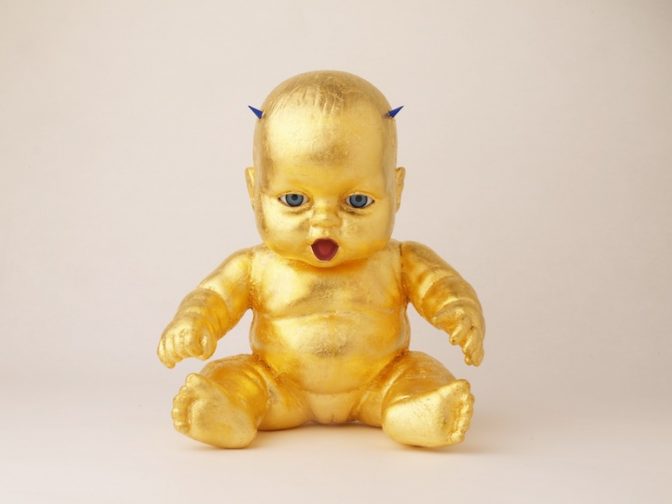
Golden Baby II - Blue Eyes
2007
17 x 14 x 10 cm

Installation view

Installation view

Installation view

Installation view

Installation view

Installation view

Installation view

Installation view

Installation view

Installation view

Installation view

Installation view

Installation view

Installation view
ZONE: CONTEMPORARY ART (formerly known as ZONE: Chelsea Center for the Arts) proudly presents a group show of significant emerging artists from Taiwan, India, Pakistan, Thailand, Japan and North Korea, as the inaugural exhibition in its new 57thStreet location. Today, contemporary Asian art is often defined by a homogenous international art market that focuses predominantly on China. Yet, by widening our peripheral vision we discover relatively young artists who are creatively engaging with their own diverse traditions while expressing their personal visions. The speculative potential of these artists, most born in the 1970’s, is extraordinary.
Yao Jui-Chung bridges the gap between traditional and contemporary. Yao’s large-scale ink drawings are based on familiar Asian pictorial strategies but include sharp contemporary content, often sexual. Golden Baby II – Blue Eyes, a plastic doll covered in gold leaf, gives the pudgy female form, embellished with tiny horns, the numinous mystery of an idol. The iconic golden baby personifies the next evolution of global art.
Ryota Unno also references earlier Asian art with multi-incident narrative paintings. His lively mix of humor and satire incorporates modern tanks and mundane human activities in Edo-style panoramas.
Krishna Murari’s multi-media fiberglass sculptures are both social critiques and powerful totems. The female figures are covered in goat hide, alluding to women in India being treated like domestic animals. Yet the strength of the figures suggests primeval dignity. Murari’s wit and aesthetic force lift him far above the level of merely polemical art.
Manil Gupta finds an original way to translate concerns about destructive human behavior into vibrant visual form. His recent black-and-white acrylic paintings owe much to both Pop and Op Art. But his sinewy stripes and decapitated figures have a unique dynamism, provoking thought as the viewer unravels labyrinthine patterns.
Mahbub Shah reinterprets the grid in his labor-intensive collages, remaining true to the Pakistani classical miniaturist tradition. Meticulously assembling found media materials, he creates images that float between representation and abstract geometry that are reminiscent of early forms of computer art, based on pixels.
Pure geometry has often been understood as a mode of access to the spiritual. Kisho Mukaiyamacreates meditative boxes, combining oil paint and wax to capture light. His craftsmanship honors local art-making traditions and esoteric Buddhism, while his simplicity relates to Joseph Beuys and Josef Albers.
The global nature of contemporary art is epitomized by Navin Rawanchaikul, a Thai artist with roots in the Hindu communities of what is now Pakistan. He also holds permanent resident status in Japan. His Navin Production Co., Ltd. organizes numerous projects that explore how local circumstance interacts with globalization trends. He uses taxis, painted with poster images in various languages, as traveling galleries to bring art to remote communities.
Finally, this exhibition offers an unprecedented opportunity to view a remarkable collection of DPRK Posters (Democratic People’s Republic of Korea). Since contemporary art has been largely banned under the Communist regime, these propaganda posters represent the only visual outlet for artists, who remain anonymous and whose subject matter is strictly controlled. Yet the graphic energy of many of these images shows considerable talent. If North Korea follows the pattern of China, these social realist images may become the seeds of a new art, when the political climate changes. While these works reflect a very different mindset from the personal visions of the other artists in the exhibition, they open a tantalizing window into what may be the next front line in Asian art.
Front Lines: Visions from Southeast Asia reminds us that all art, like all politics, is local. The art world often seems to be a “geography of nowhere,” in which artists from across the world become interchangeable commodities. The artists in this show, in contrast, demonstrate both commitment to their own regional identities and openness to global dialogue.
ZONE: CONTEMPORARY ART recognizes Ombretta Agro Andruff, David Heather, Natane Takeda and Jack Tilton for their curatorial collaboration.
FRONT LINES: Visions from Southeast Asia
November 7 – December 31, 2008
Opening Reception
6-8PM, November 14, 2008
Artists in exhibition:
Manil Gupta
Yao Jui-Chung
Kisho Mukaiyama
Krishna Murari
Navin Rawanchaikul
Mahbub Shah
Ryota Unno
DPRK Posters artists
Related:

art in ASIA review on Front Lines: Visions from Southeast Asia
Categories: exhibitions
Tags: Front Lines